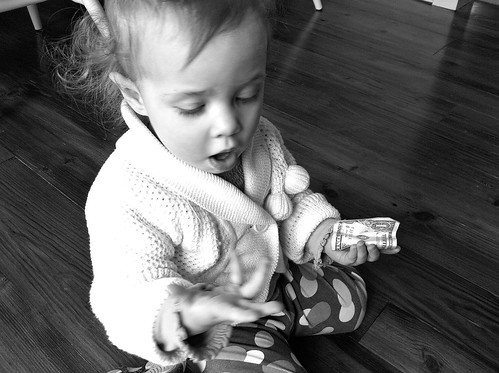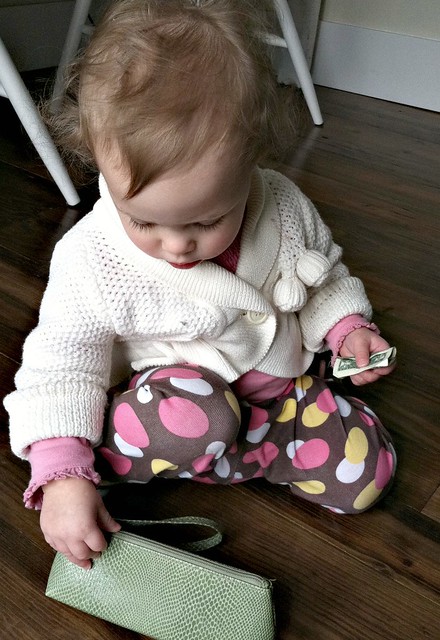This topic has been on my mind for quite some time now… and while I’m excited to share these stories and tips form my own frugal journey, I’m also just a tad hesitant since publicly sharing any sort of financial information can often be seen as “tacky”, “too up-front”, or even “boastful”.
However, if possible, please try NOT to read into the specifics of this post too much. I’m sharing what worked for Dave and for me in hopes that it will inspire some creative savings ideas in your own life. Our specific percentages and figures might not work exactly for your budget… but they might motivate you to come up with a plan that will work for you.
Also, I must remind you that I am not a financial advisor — just a frugal mom and wife striving to manage our financial resources the best way I know how. I’d urge you to consult with your own financial advisor before taking any drastic measures. 🙂
Dave and I both have parents who know what they are doing financially. This does NOT translate into “wealthy families” — but rather, families who live within their means, live frugally, work hard, do without when necessary, splurge occasionally, and teach their children to do the same.
Thankfully, Dave and I both listened!
And while we don’t have a lifetime full of money-mastering tips, Dave and I have learned a lot about finances from our parents, from my 6 years of business experience, from our own financial investors, accountant, and bank managers, and from other more experienced individuals. We’ve worked hard to take as much of their advice as possible, do what they did, live how they lived — BUT to do it in a way that also fits with OUR financial goals, OUR vision for the future, and the way WE want to live OUR lives.
So since my mission in life is to simplify everything, I’d like to share two of the MOST helpful (and extremely doable) pieces of financial advice Dave and I have received throughout the years.
I’m fairly confident that YOU — yes you — can implement either (or both) of these two tips no matter how much money you make, no matter what your monthly income and expenses are, and no matter how financially incompetent you think you might be.
They are not rocket science by any means — in fact, Nora was shocked when I explained my simple tips — but they should help you to save and/or invest more.
1. Directly deposit SOME of your pay check into savings.
One of the first things Dave and I did after we were married was to set up two joint bank accounts — one was a checking account, the other was a savings account.
Since Dave and my paychecks were relatively equal, we had Dave’s full paycheck directly deposited into our checking account and my full paycheck directly deposited into our savings account. Then we committed to ONLY living off the money in our checking account and not touching the money in our savings account for a year.
After that year, we had a fully-funded emergency fund that could essentially last us 12 months if needed.
From then on, we continued to pay all our monthly bills and expenses from our checking account and only used the money in our savings account to pay down our mortgage, pay off our student loans, and help fund larger “projects” — like our kitchen renovation.
So the point I want to make is not that you should or shouldn’t live off 50% of your income — it’s that by directly depositing at least some of your paycheck into a savings account (and not touching it for several months) you WILL save more than if you didn’t.
Even if you only deposit $10 from every paycheck — you’ll end up with more than $250 at the end of the year!
Now, I realize these are tough economic times, but I have to believe that almost anyone could shift their budget around and make-do with $10 less per paycheck. Skip 2 cups of fancy coffee, one fast-food meal, or 3 gallons of gas and you’re there! And wouldn’t it be fabulous to have an extra $250 (or more) in a savings account come Christmas.
By directly depositing some of your monthly income into a savings account, you don’t get a physical check — which means you don’t have to think about it. You don’t have to go to the bank and manually deposit the money, you don’t have the opportunity to change your mind or decide you’ll start saving “next month”, and you don’t have the opportunity to spend that money without consciously making an effort to transfer it back into your checking account (which I wouldn’t suggest doing!)
It’s crazy how quickly the money will build up — especially if you do more than $10.
Take a moment to really look at your budget. What can you afford to put into savings? Take that estimated number and then add another $5 or $10 to it — just to see if you can live a little more frugally.
Then sit back and don’t check your savings account for a few months — it will be so fun to log on (or look at your paper statement) and realize how much you have sitting in your savings account with almost no effort on your part.
2. Automate your investments on a monthly basis..
So I’m most definitely not an investment expert — but this tip has helped us to not only think about investing a little bit more, but also accumulate a nice little investment “cushion” that we can continue to grow and save for a rainy day.
It is important to realize that unlike building a savings account, investment money is money you COULD lose if the market crashes. If you are new to investments, I’d suggest that you start small, be informed, only invest money you can live without, work with a trained financial advisor you trust, and be prepared to let your money sit for many years.
That said, if you’re looking for a really simple and relatively safe way to test the world of investing, I would encourage you to automate your investments on a monthly basis.
Similar to my savings example above, you can literally start super small by having $10 per month automatically withdrawn from your checking account and put into some mutual fund (let your financial advisor decide). It might not seem like much now, but in a couple years (or more if you don’t need the money) you might be surprised how quickly that money will grow — especially if the market is good!
Dave and I have one relatively “safe” mutual fund investment that we’ve been contributing to for almost 2 years. Each month $200 is automatically withdrawn from our checking account and deposited into our investment account — when I checked the balance (mainly to write this post) I was pleased to see that it’s valued at almost $9,000. If you do the math, our money has doubled in less than 2 years… and we did nothing.
While this sounds quite simple (it IS simple!), I can almost guarantee we would not have been as diligent with investing if it wasn’t automated… and it certainly wouldn’t have been as easy to save all that money if it was just sitting in our checking account staring us in the face.
Hypothetically, if you put $10 per month into an investment account (and it doubled) you’d have $480 after 2 years!
Not too shabby!
Obviously, it doesn’t always work like this — but by automating our investments, Dave and I have been able to build our investments more quickly (and we’ve learned a lot too!) It doesn’t matter if the market is good or bad, if we have more bills than normal or extra income, we always know that $200 is going to our investments — no matter what. Yes, we can stop that transfer at any time, but by keeping things automated, we never forget to write the check, or decide that we don’t want to part with our money that month.
And as you can see by the figures above, the diligence pays off!
Yeah, we’re already teaching Nora to save, save, save 🙂
So like I said at the beginning of this post, my hope is that by sharing some personal stories from my own frugal journey, you’ll be motivated and inspired to create a savings and investment plan that will work with your budget and your life.
I can’t stress enough that even the smallest amount of money CAN make a difference. And if you work with a bank or investment professional who makes you feel stupid for saving or investing such a small amount, find a new bank or a new investment company! Seriously!
Don’t put your savings or your investments off until next week or next year. Take action now and who knows what your money could do over the next two years!








Lindsey H says
Very good info. I like the part when you talk about loving off of 1 income for a year. I think that is totally do-able, and we are getting married in November! Keep the awesome info coming!
Tori says
We save all of our coins and use them to help fund travel to see family. It really does add up!!!
Kalyn Brooke says
The word investment always sounds so serious and foreboding. Lol 🙂 I never really quite understood the stock and bond market, but I do like investing in CD’s and my husband and I are working toward rental properties as our retirement investments. Housing can still be a volatile market though, and I like your idea of the mutual fund. Will have to do some more research!
Keeley says
Love your good tips. Thank you for sharing good simple tools which will make a positive impact on many.
doreen@househoneys says
Paying yourself first is super important, because we all know how quickly money disappears. I remember my husband’s company, like many, had a 401 plan and many people didn’t contribute because they ‘couldn’t afford it’. In many cases, people can’t afford NOT to contribute. Time goes by so quickly, and before you know it you’re staring retirement in the face and have little or nothing to fall back on.
Unfortunately, like many others, our 401 was reduced by around 40%. Also, many companies have either eliminated 401’s or reduced their contribution. Nevertheless, a forced savings plan should be a top priority as soon as possible. You’re never too young to start!
Rebecca says
or too old! Just start!
Lauren @ Rustic Honey says
This is such great advice! As newlyweds, my husband and I have gone back and forth on how to group all of our investments. We would both really like this simplified method you have presented above! Thanks for sharing! Looks like Nora already has it down 🙂
Ashley Klaus says
Hi Andrea,
Do you have any recommendations for a free online budget form? I have found some that look decent, but they cost money! Any recommendation would be appreciated 🙂 Love this post; thanks for sharing!
Ashley
Ree Klein says
Hi Ashley, I blog at http://www.EscapingDodge.com and yesterday I published the second post in a two-part series called “Does Your Spending Support Your Values.” This topic discusses how to track your spending and I’ve provided a FREE worksheet that is also a great start for designing a budget. I’d love you to try it out and let me know how it works for you. Feedback is great!
Andrea: I love this post. I also squirmed about how much to divulge on my About Me page. I ended up going with full disclosure because I felt it was the only way to build credibility and inspire others. Your site is great; I really enjoy your posts and the awesome pics of your home and Nora. Thanks!
Ree
Amanda says
On top of some of your other tips, which we already do (although our investments are in the form of a 401k, but it still comes straight out of our paycheck, and we never miss the money because we’ve never had it. We take out the max amount that our employers will match so that we are getting the most out of it), we embarked on a plan I saw on pinterest at the end of 2012.
Essentially, we put into savings the same amount of dollars as the week of the year. So the first week of Jan was $1 and the last week of the year will be $52. At the end of the year, that will be just shy of $1400. Sure, it will get more difficult as you get into Nov/Dec, but it is totally worth it. We are using that money towards buying a new fridge (although we’ll probably be buying it in Nov when prices on fridges are super low). However, it would be great to have that money socked away for holiday spending (gifts/extra food for entertaining/etc.). We intend to do it every year from here on out (it’s been so easy so far) and use it as our home improvement budget.
Also, I do some focus groups throughout the year, and that money gets put into our savings account. I figure it’s not money we count on, so we just save it 🙂
Andrea says
Yes Amanda, I recently posted a 52 weeks saving plan on my Facebook page 🙂
Dave and I also contribute to 401K’s and we each max out our ROTH IRA’s every year. I guess I didn’t include that in this post since it’s money reserved for retirement — and we can’t access it for a LONG time (unlike our other savings and investments accounts!)
Rebecca says
I think this is a great idea (never heard of it before) because it has a game-like quality to it. However, since ALL our birthdays are in the fall, as well as all the holidays, our car tags, and school expenses, I would be tempted to do this in reverse. Start with $52 and work my way down to $1 the last week in December. That way we could save the most when we could most spare the extra (and also get more interest!). I am going to figure out where we are right now and give it a go!
Amanda says
I have a friend, her husband has a job which is very seasonal, so they have some very lean times and some more prosperous times throughout the year. She decided that she was going to skip around a bit. When her husband is in his high season she’s saving the higher amounts, and when he’s barely/not working, the lower amounts. She just hung the list and is crossing off each week as they got. So I think doing the reverse would work equally as well! I think any way to save up some extra money is a worthwhile venture 🙂
Melissa says
I think most areas of life go more successfully with a plan and finances are no exception! Thank you for sharing some of the details of yours with us. A little more than a year ago I got very serious about paying off my student loans and building an emergency fund and figured out ways to create more room in our budget and stretch our pennies further. Those small extra payment amounts do add up. I’m currently 22 months ahead in payments (like most student loans, it’s a ten year loan) and watching those months get shaved off the loan term is very motivating!
My husband and I have a 401K type option through our jobs so we have money automatically taken out each pay period to go into that. Even little amounts really do add up!
Susan says
Love it! I love that you have encouraged people to start small. Saving can seem overwhelming–but anyone can cut here or there. I am a waitress, and we just started saving a mere 5% of my tips every shift to put toward an all-inclusive vacation for our 10-year anniversary in 2 years. With our kids in a Christian school, I hadn’t thought a bigger vacation for us would be a possibility. But with only that small percentage, we’ve already saved over $100 in about a month! Small amounts CAN and DO add up!
Emily K says
Awesome tips!! Amazing how manking the money seem “not there” just by putting it into another account works. 🙂
Shannon says
Hi thanks so much for your post. I have been doing your tip number one for sometime now & it is so exciting to see that money collect without doing anything. My struggle is moving on to number 2. I would love to open a mutal fund but I’m scared(lol) I want a safe one. We are a family of 5 living on a very tight income & we can’t afford to lose money! Right now I would only be able to invest about $10-$20 a month. Could you recommened a safe mutal fund? I have no idea where to start! Thanks so much Shannon
Andrea says
Hey Shannon, As I mentioned in the post, I am NOT I financial expert so I definitely wouldn’t ask me for investment advice 🙂 I don’t even know what mutual funds we invest in as our financial advisor takes care of it all. We trust him and his opinion, so we let him take care of that for us.
Melissa says
Ask your friends and family if they use a financial advisor or know of someone who does. Word of mouth is great for finding these types of people. We are using Edward Jones and a specific agent recommended to us by my husband’s aunt. He’s turned out to be a really great contact for us and helped us figure out what to do, how to invest and what the costs are etc, it’s been a great learning experience and he takes care of all of it, but we’re informed and investing and building our funds. (We opened two Roth IRAs).
Betty says
Very nice article! Thank you for the suggestions and for sharing what has worked for your family. It works! ~ Have a beautiful & safe weekend! Think Spring Weather!
Sherry says
Your second tip takes advantage of Dollar Cost Averaging. By investing the same amount each month you end up buying more shares when prices are lower and fewer shares when prices are higher thereby lowering the cost overall of your shares. It’s very good investment advice!
shelly says
Thanks for the post. We are a one income family and we do this every pay period. One thing that we have done as well is when we get the urge to go out to eat most generally we will lets say get a bag of shrimp for 8.00 and put the rest of what we would have spent going somewhere in savings. Typically for our family of 4 we spend about 24.00 if we eat out so we would transfer the savings (16.00) and have a fancier meal (shrimp) at home.
Luba says
What a great idea, Shelly. My husband and I will do something like this as far as food goes, but we should transfer the money to savings like you do!
Norma says
I have another tip I can’t remember where I read it… Save 1 dollar each day… I have an automatic transfer scheduled for every Friday to have 7 dollars transfered to my savings account. It may not seem much but it is a great way to start, plus I can almost guarantee, you won’t miss the 7 dollars a week. (I do this in the equivalent of mexican pesos since I live in Mexico).
The other one is to save bills of a certain amount. Here 20 pesos is the same as 1.50 or 1.60 dollars. So when I get change for something and get 20 pesos bill back, I save it. I’ve done this only during specific time, for example during a vacation I saved all my 20 pesos bills… I came home from vacation with a nice amount… directly to the bank 🙂
Zolane says
Great advice, Andrea. A little can add up very quickly and is typically not even missed 🙂 Thanks for the tips!